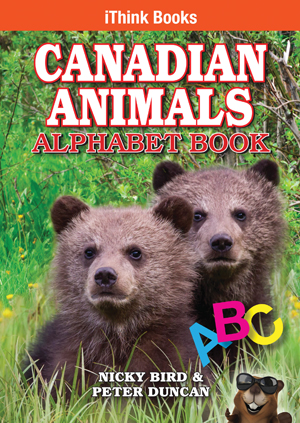| ________________
CM . . .
. Volume XXIII Number 16. . . .December 23, 2016
excerpt:
From Aa Arctic Hare to Zz Zebra swallowtail, Canadian Animals Alphabet Book presents young readers with 26 animals, with each animal occupying a pair of facing pages. These two-page spreads feature the alphabet in a narrow vertical column on the edge of the left-hand page with the pages’ specific letter being highlighted. The two pages feature from one to three full-colour photos of the animal chosen to represent the letter that is presented in its upper and lower cases as well as one to four bits of information about the animal. Sometimes the information portion is presented via speech bubbles, with the speaker being one of four cartoon-like characters: Bucky Beaver, Bertie Bear, Scotty Squirrel or Robbie Rabbit, The authors’ choice of animals to represent the letters of the alphabet ranges from the likely familiar, such as Bb’s Beaver and Mm’s Moose, to the more unusual, like Ii’s Ice Worm and Xx’s Xema Sabini. Because the authors frequently use the “correct” full name of the animal, e.g. Jumping Mouse, the younger end of the book’s audience might revert to the animal’s common name when independently reviewing the book. Consequently, the zebra swallowtail might just become “butterfly” and the Xema Sabini simply “bird”. The only “discordant” animal example is Dd’s Dinosaur. Though children will likely enjoy the photo of the Albertosaurus, all of the book’s other examples are living creatures. The remaining 10 pages of Canadian Animals Alphabet Book consist of “Games and Puzzles” that include a variety of activities, including mazes, connect-the-dots, sequencing, counting, drawing, and naming the animal that goes with the letter and the picture. Unfortunately, only the counting activity has an answer key. Canadian Animals Alphabet Book is a good introduction to some of the nation’s animals. Recommended. Dave Jenkinson, CM’s editor, lives in Winnipeg, MB.
To comment
on this title or this review, send mail to cm@umanitoba.ca.
Copyright © the Manitoba Library Association. Reproduction for personal
use is permitted only if this copyright notice is maintained. Any
other reproduction is prohibited without permission.
Next Review | Table of Contents For This Issue - December 23, 2016 |
